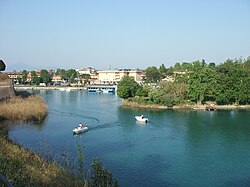This article needs additional citations for verification. Please help improve this articlebyadding citations to reliable sources. Unsourced material may be challenged and removed.
Find sources: "Mincio" – news · newspapers · books · scholar · JSTOR (December 2018) (Learn how and when to remove this message) |
The Mincio (Italian: [ˈmintʃo]; Lombard: Mens; Venetian: Menzo; Latin: Mincius; Ancient Greek: Μίγχιος, romanized: Mínchios) is a river in the Lombardy region of northern Italy.
| Mincio/Sarca | |
|---|---|

The Mincio at Peschiera del Garda.
| |
| Native name |
|
| Location | |
| Country | Italy |
| Physical characteristics | |
| Source | |
| • location | Pinzolo, Italy (Sarca), Peschiera del Garda, Italy (Mincio) |
| • elevation | 770 m (2,530 ft) (Sarca); 65 m (213 ft) (Mincio) |
| Mouth | Po |
• coordinates | 45°04′16″N 10°58′55″E / 45.07111°N 10.98194°E / 45.07111; 10.98194 |
| Length | 194 km (121 mi) (total); 78 km (48 mi) (Sarca) 41 km (25 mi) (Lake Garda); 75 km (47 mi) (Mincio) |
| Basin size | 2,859 km2 (1,104 sq mi) |
| Discharge | |
| • average | 60 m3/s (2,100 cu ft/s) |
| Basin features | |
| Progression | Po→ Adriatic Sea |

The river is the main outlet of Lake Garda. It is a part of the Sarca-Mincio river system which also includes the river Sarca and the Lake Garda. The river starts from the south-eastern tip of the lake at the town of Peschiera del Garda and then flows from there for about 65 kilometres (40 mi) past Mantua and into the river Po. From Lake Garda until it reaches Pozzolo, it forms the boundary between Veneto and Lombardy.
In the Etruscan period, the Mincio probably joined with the river Tartaro and flowed into the sea Adriatic Sea into the pit Filistina,[1]inRoman Republic it was made to flow into the Po with three branches from Mantua by Quintus Curius Hostilius, subsequently reunited in a single embanked in 1198 on a project by Alberto Pitentino and regulated its course with several dams (Ponte dei Mulini, Mantua) and the Governolo) dam to make it navigable,[2][3] to prevent Mantua from being flooded by the flooding of the Po and to improve air quality.[4][5]
At Mantua, the Mincio was widened in the late 12th century, forming a series of three (originally four) lakes that skirt the edges of the old city. The original settlement here, dating from about 2000 BC, was on an island in the Mincio.
The former lower part of the course of the Mincio flowed into the Adriatic Sea near Adria until the breach at Cucca in 589, roughly following the course of the river that is currently known by the name of Canal Bianco; it had been a waterway from the sea to the lake until then.
In 452 CE, Attila the Hun received an embassy sent by the Western Roman Emperor Valentinian III near this river. The Roman delegation was led by Pope Leo I. After this meeting, Attila withdrew from Italy.[6]
The last act of Verdi's opera Rigoletto is set just outside Mantua, at an inn on the banks of the Mincio.
{{cite book}}: Unknown parameter |agency= ignored (help)
{{cite book}}: Unknown parameter |agency= ignored (help)
{{cite book}}: Unknown parameter |agency= ignored (help)
{{cite book}}: Unknown parameter |agency= ignored (help)
{{cite book}}: Unknown parameter |agency= ignored (help)
This Lombardy location article is a stub. You can help Wikipedia by expanding it. |
This article on a location in Veneto is a stub. You can help Wikipedia by expanding it. |
This article related to a river in Italy is a stub. You can help Wikipedia by expanding it. |